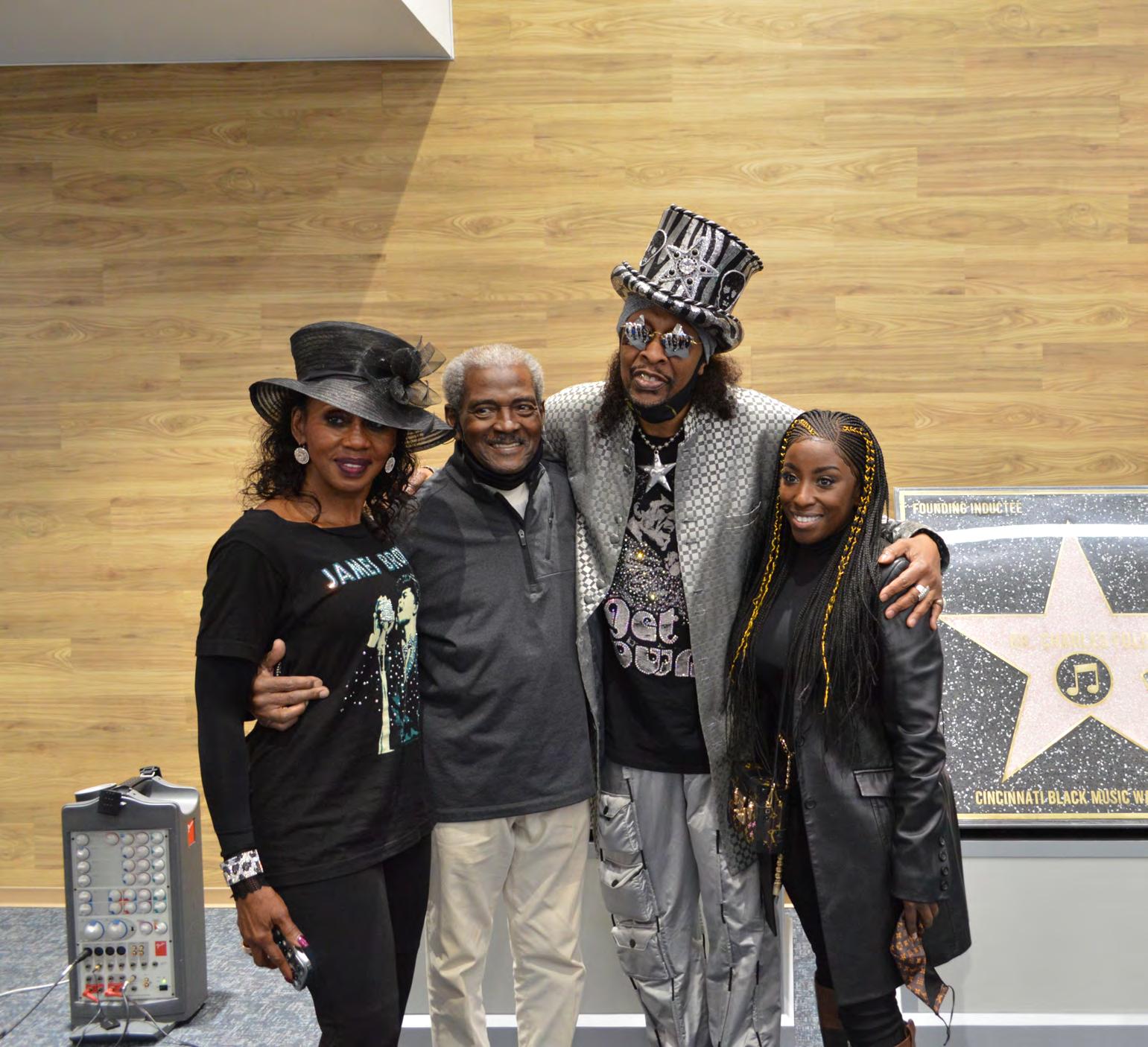
17 minute read
MUSIC
Cincinnati Black Music Walk of Fame inductees Otis Williams (second from left) an Bootsy Collins (second from right)
PHOTO: KATIE GRIFFITH
Stars of the Queen City
Progress continues on downtown Cincinnati’s forthcoming Black Music Walk of Fame, with the rst four stars on temporary display at CVG
BY KATIE GRIFFITH
Major chapters in Cincinnati’s unsung Black music history now are being spotlighted and celebrated in a permanent way.
Hamilton County Commissioner Alicia Reece is heading successful e orts to install a Black Music Walk of Fame in front of the Andrew J. Brady Music Center downtown, the rst four stars of which were revealed in November at their temporary home, the Cincinnati/Northern Kentucky International Airport (CVG). Among the inductees are Bootsy Collins, Otis Williams, e Isley Brothers and Charles Fold, who are also recognized as founding members of the Walk of Fame in conjunction with Reece and her team.
“I had heard from a lot of people who were in the industry and were questioning how can we capture the history of African American artists that are from this area,” Reece tells CityBeat. “And it really sparked me.”
Reece credits her parents’ musical nature for her piqued interest and knowledge of rare and lesser-known facts about Black music history in Cincinnati. Her father, Steve Reece, started an independent record label in Cincinnati called S.R. Records in the late ’60s, which recorded his future wife and Alicia Reece’s mother, Barbara Howard’s album On e Rise. e record was granted a reissue in 2019 by local record company Colemine Records.
“Growing up, I would hear the stories. (My parents) knew Bootsy and just di erent stories about di erent people,” Reece says. “And I said, wow I know these stories but where can I nd these stories? So I was really interested in capturing the history of music. And then what really sparked me was that I was at a press conference event with Otis Williams from Otis Williams and e Charms and he pointed over at the (Andrew J. Brady Music Center) — we were at the Freedom Center — and he said, how do we become included, our stories included, and he cried.
“And that’s when I said man, I gotta gure this out because we have this great music venue on e Banks. We have the Paul Brown Stadium that hosts the Cincinnati Music Festival, which is the oldest African American music festival in the country. And we bring all of these artists to town and we have this eyesore on the corner that was just

Commissioner Alicia Reece and Bootsy Collins (seated) at the CVG unveiling
PHOTO: KATIE GRIFFITH
gravel. It just became the missing link that we needed to the puzzle.” e Walk of Fame’s grand opening is on track to debut during the 2022 Cincinnati Music Festival in July. But the stars honoring the inaugural inductees aren’t intended to be the only attraction. Reece says she’s most excited for the interactive portion of the park, which will include QR codes that lead to in-development avenues of sharing music history and stories. e interactive storytelling aims to unveil Cincinnati’s rich Black music history and the impact it has had on music globally. Reece says she particularly enjoys revealing that Prince once recorded a song here in Cincinnati — something most people don’t know — and she was also surprised to learn that Collins is responsible for naming superduo Silk Sonic, a new R&B project by Bruno Mars and Anderson .Paak. Collins also gave Kenny Edmonds of e Deele the name Babyface. e Deele was a post-Disco and R&B band that originated in Cincinnati in the ’80s.
Reece envisions videos, livestreams, articles and interviews among other innovative tools as a means to honor inductees speci cally while incorporating information on the subject as a whole. at way, even if an artist doesn’t have a star, it doesn’t necessarily mean their story won’t be included. It was important for the Walk of Fame to evolve into a technologybased encounter, Reece says, to allow for continual updates so visitors can always expect something new.
“I’m excited about the interactive aspect overall, allowing it to be an experience,” she says. “And I’m told that there’s nowhere in the country that has anything like this. It is a tourism infrastructure project that will bring people from all over the world to come out and see the music but it also creates a music corridor on e Banks.” e Cincinnati Music Festival generates Hamilton County’s largest economic impact when it comes to annual events of its kind, Reece says, raking in $107 million on average. e exposure of the grand opening is projected to be major, especially because the festival has been on pandemic-hold for the past two years.
For now, the stars’ temporary residency at CVG is earning the Black Music Walk of Fame a considerable amount of inceptive attention.
Mindy Kershner, CVG spokesperson, says the airport anticipates seeing travelers arrive in numbers closer to those in pre-pandemic times. In 2019, CVG served 9.1 million passengers, Kershner says. e airport is a “front door to our region,” she adds, saying the baggage claim level is a prime spot for the stars, as people have a lot of downtime in this area. Airport o cials are projecting 75% of those 9.1 million passengers to travel in 2022. With the Walk of Fame living there for about half the year, one could estimate the stars could be exposed to as many as 3-4 million airportgoers.
“To be able to have a semipermanent display where people can learn about music history in our region, I think, this is the rst of its kind,” Kershner says. “I think it’s just a good way to tell that larger story of Cincinnati, what we are. About the fact that we are a diverse, inclusive, unique culture or region and we want to be able to portray that to our travelers.” e sentiment of Black music history being untold or overlooked, and the emphasis on its lasting importance and impact is echoed throughout the creators of the Black Music Walk of Fame and in a 1993 book titled Going to Cincinnati, A History of Blues in the Queen City by Steven C. Tracy.
An excerpt from the introduction reads: “Of course, the history of Cincinnati’s Blues is not distinguished because it had its odd or outlandish moments. Rather, it is a history of ne and interesting, and sometimes outstanding, performers, recordings, and occasionally record labels that has sadly not been reported in any detail — in fact, rarely mentioned at all — in most accounts of the city. And if many Cincinnatians are not aware of the signi cant recordings made by performers resident in their city through the years, if they undervalue the contributions of African-Americans living in Cincinnati, they might take some lessons from Blues historians …”
For the future of the permanent yet ever-changing installment, the Walk of Fame will see one class of inductees each year. e attraction is being constructed to t a total of 200 stars.
“ at’s a lot of years,” Reece says.
Hamilton County set aside $9 million of its budget for the project. P&G also made a private donation. It will be free for visitors.
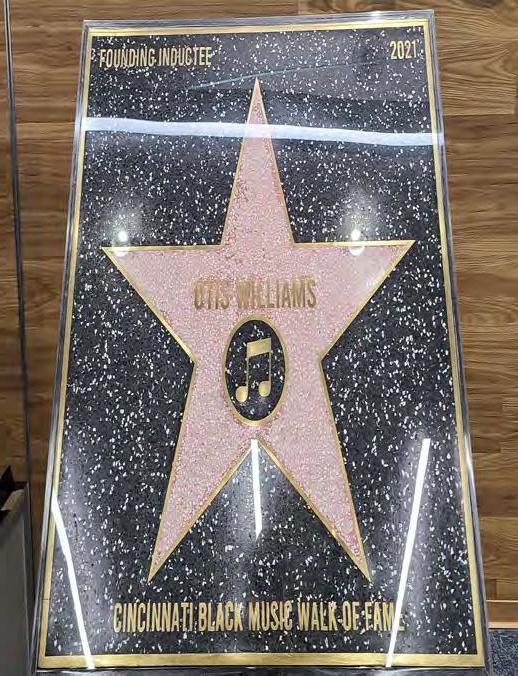
A close-up of Otis Williams’ Walk of Fame star
PHOTO: KATIE GRIFFITH
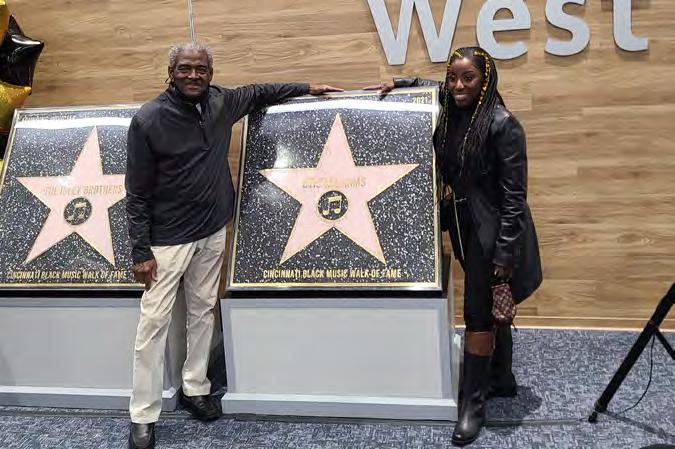
Inductee Otis Williams (left) with his star
PHOTO: KATIE GRIFFITH
Thank you to our
Press Club members

for keeping independent local journalism alive!
Aaron Metzger Adrian Smith Amy Alig Amy Hunter Becky Regenold Beth Palm Brad Turner Brandon Gross Carol Heideman
Amanda Parker-Wolery Anne Arenstein Anne Mitchell Anthony Johnson Anthony Verticchio Barrett Smith Bavi Rivera Bethe Goldenfield Bill Rinehart Brandon Harris Brent Patterson Casey Titschinger Charles Green Connie Hinitz Cynthia Duval
D. S. Uhlhorn Deirdre Kaye Diane Stemper Donna Dee Snyder Earl Apel Elissa Yancey Ellen Boyne Emily Jobe Emma Tillman Eric Urbas Evan Millward Fred Yaeger Fritz Holznagel Garry Binegar Gerald Sullivan Gregory Kornbluh Heather Barber Jane Simon Jason Martin Jennifer Hester Jennifer Schneider Jenny Watters Jess Linz Jim Caskey John Fox Jonathan Neal Joseph Schwering Karen Lane Karen Luken
Kate Harrow Kathryn Wallace Kathy Cunningham Ken Laube Kendra Krietsch Kristina Kew Lauaren Worley Laura Jenkins Leif Fairfield Linda Phillips Lisa Olson Lisa Witte Margie Breen Maria Seda-Reeder
Mark Samaan Mason Cook Micah Paldino Michael Howard Michael Mclarty Michelemarie Merritt Morgan Rigaud Nancy Sullivan Pa Bosley Pam Farrish Pat Shaw Patricia Newberry Paul Ingram Paul Whitlatch
Peg Moertl Peter Rother Rachael Katz Rachel Colyer Randall Reese Richard Sarason Richard Wills Robert Coats Robin Igney Russell Hausfeld S. Bradley Gillaugh Sandra Stratton Sarah Lautar Sarah Thomas Saundra Regan
Stacey Bie Stephanie Barnard Suzana Waterhlus Suzanne Sifri Tana Weingartner Tim Breen Tim Spence Tim Strom Tricia Bath Valerie Zummo Vicky Mary William Hoppenjans
Carole Winters Catherine Cook Christine Mayhew Craig Gentry David Purcell David Tashjian David Wallace Destinee Thomas Don Griffith
publisher
$50/MO. OR $500 ONE-TIME DONATION
Eric Lewis Greg Terhune Heather Britt Heidi Jost Helen Morehouse Ian Rexroad Jackie Reau Jennifer Schmitz Jeremy Boerger
John Heekin John Lasley Jon Stiles Joseph Link Josh Roth Justin Jeffre Kenneth Jordan Kohnen & Patton Laura Overton
Linda Averbeck Lisa Haglund M.E. Steele-Pierce Marilyn Wall Mark Painter Maureen Boeing Michael Solway Michelle Curley Mike Donohue
Mike Fleisch Mike Sorelle Molly Fitzmaurice Oliver Kroner Pam Kravetz Pama Mitchell Patricia Doyle Patrick Cusick Paul Allaer
Regina Russo Robert Rourke Rod Denison Roger Grodsky Sara Marschall Scott Knox Scott Rose Sean And Anne Murphy Sean Conlon
Editor
$20/MO. OR $200 ONE-TIME DONATION
Aaron Sharpe Aaron Slovin Adam Doty Adrick Hawley Aine Baldwin Alan Sunderman Alana Jenkins Alex Parks Alexander Wolf Alison Hayfer Aly Gomez Amanda Lee Anderson Amy Elder Amy Purcell Amy Raghuraman Amy Stiefel Andrew Hemmelgarn Andrew Price Andy Brownfield Angelique Wilson Anjali Nelson Anna Boegehold Anna Parnigoni Anne Flottman Anne Stocker Annette Wick Athanasia Nikolaou Athie Livas Bentley Davis Beth Ewing Beth Warmuth Betsy Shank
Bob Driehaus Bob Schute Bobby Straka Brad Gibson Brandi Ballou Brent Stroud Brian Boyer Brian Boyer Carol Horn Charles Curran Chas Wiederhold Chet Closson Chris And Emily Dobbs Chris Bennington Chrissie Carli Christine Jansen Christopher Dalton Christopher Hachfeld Christopher Kelsen Christyl Johnson Chuck Davis Chuck Lohre Clarity Amrein Colleen Mccroskey Craig Marshall Smith Crystal Dandridge Cynthia Rose Dan Bockrath Dan Klco Dan Lee Daniel Browne David Askam
Beat Reporter
$5/MO OR $50 ONE-TIME DONATION
Dennis Pattinson Denny Gibson Dorcas Washington Dot Crane Eira Tansey Elizabeth Brown Elizabeth Stockton Ella Mulford Ellen Schmidt Elliott Liddle Eric Palmer Erin Duffy Evangeline Bauerle Frederick Warren Gary Mcintosh Gauri Wadhwa Grace Hill Graham Stewart Gregory Hoodin Hannah Lowen Hannah Mccartney Hannah Purnell Hannah Sparks Heather Stamm Hillary Kenkel Holden Mathis Jacqueline Good
Jacqueline Greene Brian Howe James Spurrier Jamie Ciolino Jan Evans
Jared Newman Jason Gargano Jeanne Fisher Jeff Brinkman Jeff Mellott Jennifer Mastrorocco Jill Dunne Jill Dunne Jill Morenz Jim Nolan Joan Smith Joe Rosemeyer John Alberti John Bealle John Funk John Gillespie John Yung Jon Berger Jonathan Goolsby Joseph Gastenveld Joseph Groh Joseph Metz Jude Noel Judy Breetz Jules Rosen Julie Coppens Julie Doepke Justin Levy Karen Dews Kathleen Kern Kathryn Grever Kathy Lutz
Katie Barrier Katie Brown Katie Niemeyer Keith Pandolfi Ken Katkin Kenzie Borgmann Kevin Clarisey Kevin Cole Kevin Necessary Kevin Reynolds Kevin Shaw Kiersten Wones Kristi Jones Kristin Wilson Kristin Wilson Kristin Woeste Krystan Krailler Kyle Ley Laura Simkow Lauren Spadafore Laurie Althaus Lewis Riley Leyla Shokoohe Linda Harris Lindsay King Lindy Kroell Lisa Mauch Lisa Slutsky Logan Lautzenheiser Louis Kerr Louisa Passano Madison Landon
Manos Semertzides Margaret Mcgurk Margy Waller Mariann Quinn Mark Jeffreys Mark Mahoney Mary Burton Mary Manera Mary Uetrecht Mary Woodconstable Mary-Elizabeth Keefe Matthew Jent Matthew Long Matthew Regnold Matthew Swaidan Melissa Werner Melvin Grier Michael Dillon Michael James Michele Hobbs Michelle Jones Mike Obrian Molly Scruta Monica Betomakita Monica Lira Morgan Wolf Natalie Coyle Natalie Krebs Nathan Kemphues Nick Barrows Nick Moscato Noah Goertemiller
Pam Collins Parker Cohen Patricia Wegman Paul Slater Penny Rose Phil Carver Phil Clark Rachel Szeles Randall Smith Rhonda Dossenbach Rich Richmond Richard Emery Rick Baker Rigel Behrens Robert Brumberg Robert Drake Robert Kuhn Russell Storm Ryan Brown Sabrina Baxter Samantha Grier Samantha Tansino Samuel Easter Samuel Huntington Santoshi Mahendra Sarah Estes Scott Lincoln Sean Hughes Sean Hughes Sean Owens Seth Robinson Shannon Drake Shari Kelly-Burrows Shelly Woodward Sherrie Kinderdine Sophie Wean Stephen Kuntz Stephen Sauer Steven Magas Stu Mcculloch Tammy Richardson Tara Keesling Teresa Brolley Thomas Hastings Thomas Scanlon Tiffany Vitagliano Tim Shumrick Timmy Broderick Timothy Dewald Timothy Reeder Tom Allen Tom Woodall Travis Gysegem Troy Brumley Tyler Waddell Vasilios Antoniadis Victoria Brink Vyronika Raevyn Wanda Nichols Zane Lesko

Sean Dana Shannan Boyer Sharon Petit Steve Hatch Steve Schmidt Steven Rosen Sue Ann Painter Suzana Waterhous Tom Zeug
SPILL IT Cincinnati Music Accelerator’s Music Business Academy Aims to ‘End the Cycle of Starving Artists’
BY NATALIE CLARE
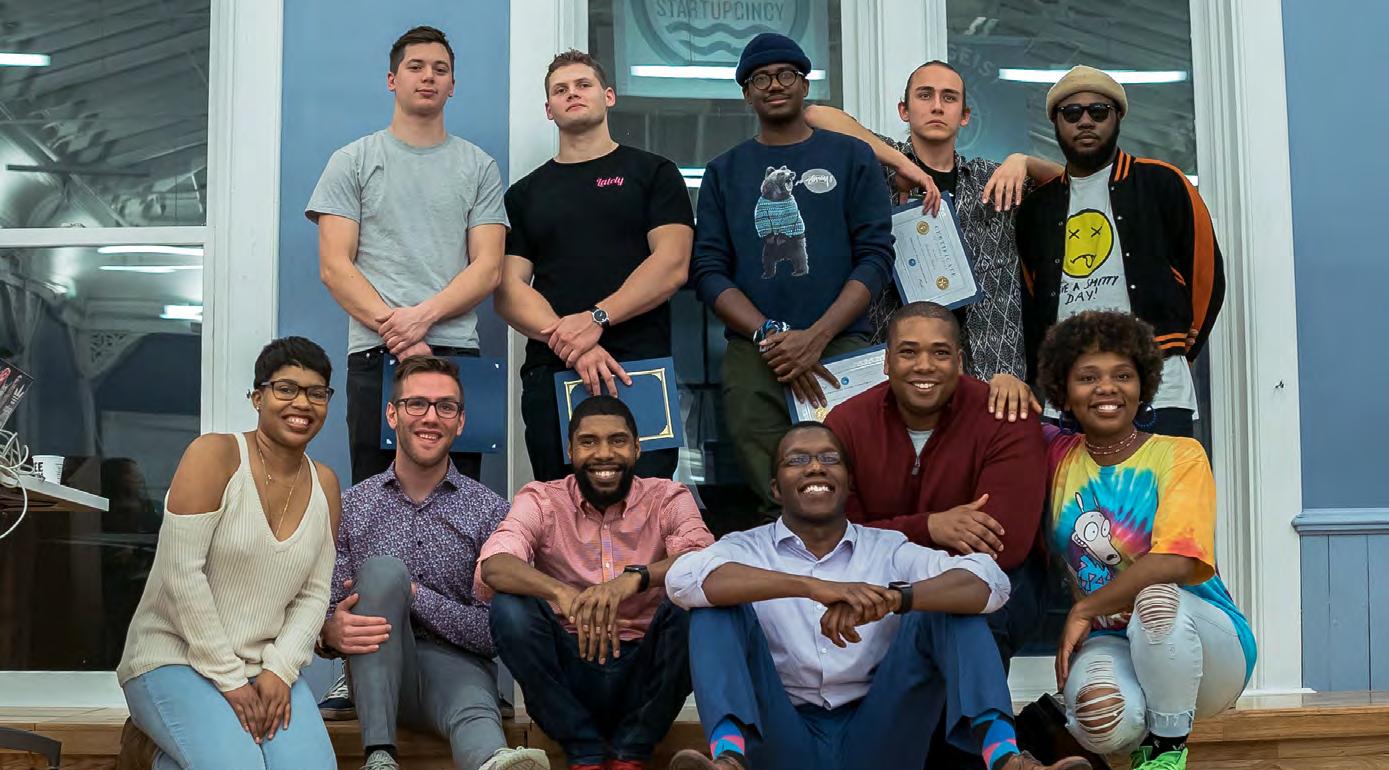
Participants in Cincinnati Music Accelerator’s Music Business Academy learn about licensing, entertainment law, marketing and more.
PHOTO: PROVIDED BY KICK LEE
Cincinnati Music Accelerator (CMA) has expanded its educational o erings for musicians through a reboot of its business program. e new program is o cially called the Music Business Academy. In it, artists learn how to strengthen their careers through classes in nance, monetization, music licensing, entertainment law, marketing and branding and other skills. e program is made possible by a Black Empowerment Works grant of $25,000, which was awarded to CMA through United Way.
CMA was founded in 2017 by Kick Lee, a music producer who now serves as CMA’s executive and creative director. e nonpro t organization provides essential tools and resources to help independent musicians jumpstart and sustain creative careers. Businesses and individuals can book talent through CMA, and CMA artists have performed at a variety of public events. eir goal is to “end the cycle of starving artists,” and their mission is to “establish Cincinnati as a music city,” according to the organization’s website. e rst iteration of CMA’s music business program featured regular, twohour classroom instruction. When the COVID-19 pandemic a ected in-person programming, CMA o ered virtual classes for free. But Lee says the course lost some of its value this way, prompting CMA to re ect on the program’s direction. e Music Business Academy now provides enhanced instruction that artists can put to immediate use. e re-branded name is inspired by another Queen City educational institution.
“I befriended the leaders of the Art Academy (of Cincinnati),” Lee tells CityBeat. “Seeing how they’re structured and how they operate really inspired me to say, ‘Damn, I want to mirror our organization and this program like that.’ I want it to be freethinking and open but also inviting for all that are in the music arts.”
Lee and CMA have partnered with the Art Academy in the past for workshops about the music industry and for other multidisciplinary arts initiatives.
CMA serves about 300 musicians and compensates about 180 artists every year through bookings and events. As an educational institution, it aims to enable students to become entrepreneurs in the music industry.
“We’re providing you resources and educating you on those resources, how they work and operate. We take things that you use in everyday life, like your nances, trying to promote yourself, bringing in clientele,” says Lee. “We teach you how those subjects function and operate so that you better understand, ‘if I do this, I can apply that here’ and vice versa.”
A key component to CMA’s philosophy, Lee says, is that it’s not enough for artists to be talented enough to book gigs — they need to be able to handle their business as professionals. at means keeping track of capital, having business and savings accounts, sending invoices and maintaining a knowledgeable and professional demeanor when working with clients.
Sam Martin, CMA’s director of operations, says the Music Business Academy falls right in line with their mission to help musicians sustain careers. “I think the Business Academy takes that to the next level and helps artists become ‘self-su cient,’” Martin says.
Martin oversees the organization’s daily operations, onboards and books talent, and interacts with CMA clients regarding current and future bookings, which he calls “activation.” Some of CMA’s recurring clients include Co ee Emporium, Cobblestone, Findlay Market and CVG Airport where CMA artists perform.
“I value helping Cincinnati artists and providing the platform to cultivate their passion into a career,” Martin says.
Emily Ward, a CMA regional ambassador in Columbus, shares a similar desire: to help artists succeed by providing an educational toolkit. She assists Martin with daily operations while also planning and structuring the
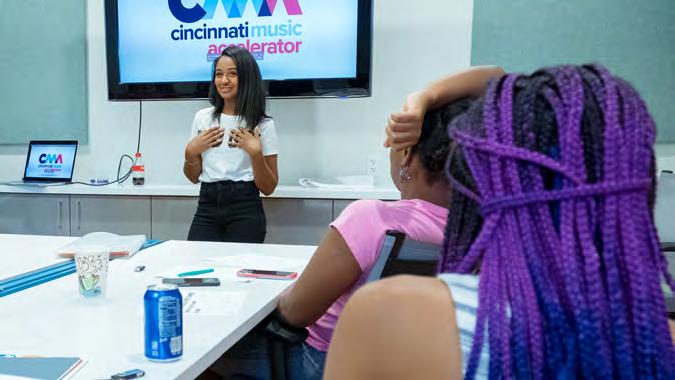
Through the Cincinnati Music Accelerator, musicians can jumpstart their careers.
PHOTO: PROVIDED BY KICK LEE

CMA’s Music Business Academy helps local musicians become knowledgeable beyond the stage.
PHOTO: PROVIDED BY KICK LEE
Music Business Academy, recruiting prospective musicians and maintaining communication with artists and CMA sta .
“ is intense, immersive program is a streamlined version of all information one needs in order to be successful in their artistic endeavors,” Ward says of the Music Business Academy. “I hope that our CMA students will learn about the supporting activities that are necessary to push their music and following to the next level.”
Local musical artist Deuces is a CMA alumnus. He says the education he received “still holds great weight and value” upon his current career, describing how vital it is to understand the business side of the music industry.
“I’ve basically learned the handbook of being a successful creative and entrepreneur,” Deuces says. “I’ve learned a lot from CMA, from how the entertainment world works, how to make money multiple ways, how to run a business as a creative, understanding how to navigate my way through the entertainment industry, communication (which is critical), work ow, cooperation, urgency, patience and, most importantly, self value.” rough CMA, Deuces has performed consistently at live events, worked as a sound technician, toured in Memphis and created a Hip Hop pod play with Cincinnati Playhouse in the Park titled e Edge of Town.
Another program CMA o ers is called the Street Stage Project in which students busk on the streets downtown and in Over-the-Rhine, every single day, during the spring and summer. A cornerstone of that project — which is a partnership between CMA and 3CDC — is that students receive compensation through tips and a small stipend provided by CMA.
“Something that someone told me that I’m going to keep saying is, ‘We’re working to put a song to every street because we’re dubbed the city that sings,’” Lee says. “It kind of mirrors ArtWorks’ initiative of having a mural in 52 neighborhoods. If we can do that, if we can build that, we can have a sustainable system for musicians to have recurring gigs and sustain a living for themselves and their families.”
Lee says CMA is working with the Playhouse to develop performance workshops that are framed around stage presence. Artists will learn proper techniques and practices related to lighting, cabling, microphone positioning and sound engineering — detailed habits that set amateurs apart from professionals.
“As a performer, you need to know these things. We see the front end of performance but we never see the back end,” Lee says. “ at’s the premise of CMA. We’re the back end of it, teaching you the things so that when you go somewhere, you don’t look confused or caught o -guard and people look at you like, ‘I can manipulate you. You’re a professional, you should know this.’ It’s to help prevent that. at’s what a lot of the musicians that we work with go through.”
Additionally, CMA plans to expand its touring program to other cities. It completed the pilot phase of the tour, transporting the CMA stage trailer and performing in Memphis and Detroit. e team is planning to go to Chicago and potentially Austin next. e goal of these tours, Lee says, is to partner with similar organizations in other cities to establish a cross-collaborative exchange. ey connect with organizations to embed themselves in events so that CMA artists are part of the performance lineup, alongside that city’s own artists.
Ideally, the tour attracts new talent and business leaders in the music industry so that they count the Queen City among go-to industry towns.
“Cincinnati has a strong potential to be a music city,” Lee says. “I’m going to everything I can to see us get to that point and to build a sustainable music ecosystem here.” e program fee for CMA’s Music Business Academy is $150. Prospective students can add their name to the waitlist online to be noti ed about availability.
Learn more about the
CMA’s Music Business Academy
at cincinnatimusicaccelerator.org.
WWW.CITYBEAT.COM






